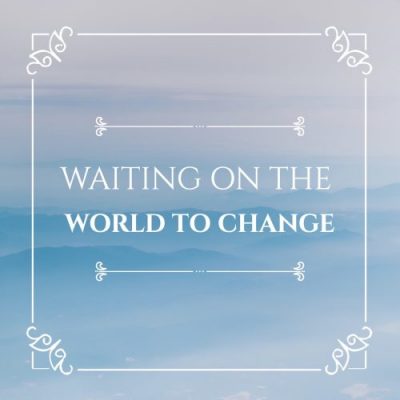Dr. Christine Moutier, M.D., American Foundation for Suicide Prevention (AFSP) Chief Medical Officer published her thoughts on how to reduce the risk of suicide. They are foundational and actionable: Research, education, supportive culture, and intervention.
Changes to Reduce the Risk of Suicide
One of my son’s favorite singer/songwriters is John Mayer. John Mayer has a song titled, “Waiting On the World to Change” (2006). In August, six months after my son died from suicide, I wrote an article that I published on a local news platform about the things I wish to reduce the risk of suicide. My dreams come with simplistic emotion, but they align with those actions that Dr. Moutier methodically articulated, plus a few more.
Research, Education, Supportive Culture, Intervention, Plus a Few More
Increase mental health education in all channels that interact with children and young adults. Schools, teachers, and counselors include suicide prevention in their curriculum. Introduce the curriculum early on, so talking about mental health and mental disabilities (including ADD/ADHD) is normal. Treat children who ask for help courageous; consider those that do so as mighty. They need to proactively follow up and follow through with students on a 504 disability plan, even if their struggles are not visible. They need to adequately staff, so ADD/ADHD students have an advocate; helping those with ADD/ADHD to be successful, could save a life.
Curriculum for children, teens, and young adults should include the warning signs of someone struggling with their mental health and how to ask for help. Require it no different than sex education or substance abuse. Use the school system as an outreach to teach parents about the warning signs, statistics, and correlations between mental illness, mental disabilities, and suicide.
Stop the glamorization of psychedelics. My son and his friends came from an excellent high school, and most of them completed secondary education; yet, as adults, they take marijuana. Schools taught children about the adverse effects of marijuana. Continue this teaching throughout high school, college, and by medical professionals. Dr. Jennifer Ashton, ABC News Chief Medical Correspondent (Twitter @DrJAshton), recently spoke on the morning news, about a spike in marijuana use by college age, young adults, the highest use in three decades. The increase in marijuana use is happening, and has adverse effects, even if the user says it is just “social.”
Adult celebrities stop glamorizing the use of psychedelics, including non-medicinal marijuana.
Create a supportive culture for our children. Schools, parents, and society teach and demonstrate inclusion, respect, caring, compassion and patience.
Bullying needs to end. Realize that it comes in many forms, beyond the outwardly physical abuse and name calling; exclusion is a form of bullying too. What the schools are currently doing is not enough. Children and teens are suffering in silence, and it stays with them forever.
Educate to reduce the negative stigma of mental illness. Create on-going communication campaigns using avenues and celebrities that reach the most susceptible age groups, and that having a mental illness or mental disability is normal and okay and seeking treatment is no different than seeking treatment for any other disease.
Expand clinical intervention programs and outreach.  Behavioral health and medical providers dig deeper and build caring relationships with their patients, getting their patients to be honest with them, and trust them. Providers follow-up with their patients, so they continue to seek care, even if it is helping to find care with someone else that is a better fit. Do not let them fall through the cracks.
Behavioral health and medical providers dig deeper and build caring relationships with their patients, getting their patients to be honest with them, and trust them. Providers follow-up with their patients, so they continue to seek care, even if it is helping to find care with someone else that is a better fit. Do not let them fall through the cracks.
Make provider more available; once every three weeks is not enough. Coordinate care between therapists, psychiatrists, and facilities, even if they are not within the same contracted provider group. Providers take every fleeting thought of suicide seriously, even if their patient says they do not have a plan.
Medical Research – There needs to be more medical research to identify when someone is at risk or has a mental illness that correlates to suicide.
– There needs to be more medical research to identify when someone is at risk or has a mental illness that correlates to suicide.
Unfortunately, most likely you know someone affected by suicide. We all need to work to reduce the trajectory in the growth of suicide rates.
You have seen these statistics on the news, but each time I see these, I am taken aback. These are US suicide statistics from SAVE.org that I think are relevant.
- Suicide is the 10th leading cause of death in the US for all ages. (CDC)
- Every day, approximately 123 Americans die by suicide. (CDC)
- There is one death by suicide in the US every 12 minutes. (CDC)
- Depression affects 20-25% of Americans ages 18+ in a given year. (CDC)
- Suicide takes the lives of over 44,965 Americans every year. (CDC)
- The highest suicide rates in the US are among Whites, American Indians, and Alaska Natives.
- Only half of all Americans experiencing an episode of major depression receive treatment. (NAMI)
- 80% -90% of people that seek treatment for depression are treated successfully using therapy and/or medication. (TAPS study)
- An estimated quarter million people each year become suicide survivors. (AAS)
- There is one suicide for every estimated 25 suicide attempts. (CDC)
I write now for many reasons. One of them to create a connections to others who are affected by suicide, to honor my son, to advocate for change so mothers do not have to suffer the grief I do by losing a child to suicide.
Now, I write as grief therapy for myself, and to articulate what it is like to be a parent of a child who died by suicide. I write to connect with those who do not know how to put into words, what they too are feeling, going through such a loss. I also want to share what the new me is going through, so others can understand. So lastly, I write to honor my son and share his story. He was such a beautiful person, and he deserves to have his story told.
Share with me your wishes to reduce the risk of suicide by posting them in the comments section.
REFERENCES
Moutier, Christine. “What We Mean When We Say #StopSuicide.” AFSP, 7 Sept. 2018, Retrieved from <afsp.org/what-we-mean-when-we-say-stopsuicide/>. Viewed February 4, 2019
Suicide Awareness Voices of Education (SAVE.org) 2018, Suicide Statistics and Facts, viewed 21 August 2018. Retrieved from <https://save.org/about-suicide/suicide-facts/>.

